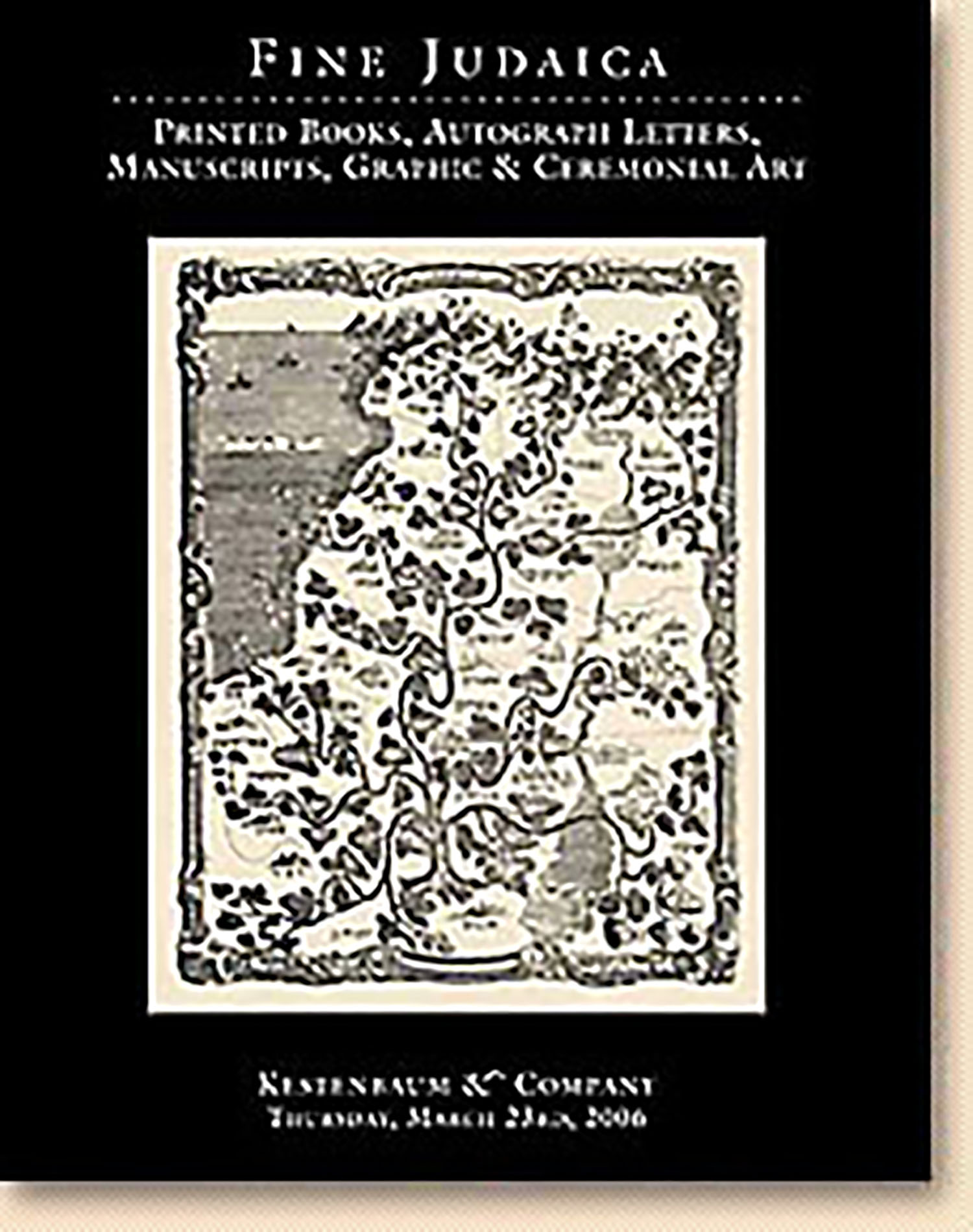PINKAS OF THE ASCHKENAZIC COMMUNITY OF AMSTERDAM, 1751-1791

AUCTION 32 |
Thursday, March 23rd,
2006 at 1:00
Fine Judaica: Printed Books, Autographed Letters, Manuscripts, Graphics and Ceremonial Art
Lot 209
(AMSTERDAM).
PINKAS OF THE ASCHKENAZIC COMMUNITY OF AMSTERDAM, 1751-1791
AMSTERDAM: 1751-1791
Est: $25,000 - $30,000
PRICE REALIZED $25,000
A fascinating Pinkas containing much original historical source material concerning significant periods of 18th-century Jewish history. Offered here, in brief, are select highlights:
THE EMDEN / EYBESCHEUTZ CONTROVERSY:
The Pinkas begins on a belligerent tone with transcripts of letters signed by individuals from the communities of Holleschau, Leipnik, and Kremsier and dated 1753, all threatening to issue a ban (cherem) against the Aschkenazic chief rabbi of Amsterdam, R. Aryeh Leib, unless he immediately cease and desist from his smear campaign against their beloved teacher, R. Jonathan Eybeschuetz of Hamburg. (They report that at the Council of Four Lands [Va’ad Arba Aratzoth] held at Jaroslav, R. Aryeh Leib accused the rabbi of Tysmanitz of having attempted to rape the widowed daughter of the cantor of Tysmanitz, only to emerge from the Council disgraced when it was discovered that the supposed witnesses to the rape had offered false testimony.) R. Aryeh Leib (1691-1755), the distinguished rabbi of Amsterdam, was the brother-in-law of R. Jacob Emden and Emden’s major ally in his campaign against Eybeschuetz. Rather than succumbing to pressure, R. Aryeh Leib’s parishioners go on the counter-offence. They remind his detractors of the spiritual stature of their mentor - the son of R. Saul, late chief rabbi of Cracow, and son-in-law of the “Chacham Zevi,” R. Zevi Aschkenazi, the previous Aschkenazic rabbi of Amsterdam. In addition, all his sons and sons-in-law are distinguished in the Law (ff. 1-3).
Moses Chaim Luzzatto
An entry for the year 1753 records a disbursement of 615.10 gold thalers to “R. Yekuthiel Rofe” on behalf of the community of Brisk, Lithuania (f.5v.). No doubt, this doctor by the name of “Yekuthiel” of Brisk would have been none other than R. Yekuthiel Gordon, who studied medicine at the University of Padua and there made the acquaintance, and eventually became the staunchest disciple, of the renowned, if controversial kabbalist R. Moses Chaim Luzzatto. It is known that from Padua Gordon returned to Lithuania and in 1742 he was sent from Brisk (Brest-Litovsk) as a delegate to Vilna. From that time on his movements are unknown. Thus, the entry in our pinkas represents a significant discovery concerning the whereabouts and activities of this most eminent disciple of Luzzatto. See JE, Vol. VII, p. 92.
The Printing of the Talmud
The printing of the Talmud has always been a lucrative endeavor, and as such, has invited stiff competition, which in turn has engendered bitter controversy. The Pinkas includes a letter dated 11 Cheshvan, 1755 from the rabbi [Aryeh Leib] and officers of the Aschkenazic community of Amsterdam to the rabbi [David Strauss] and officers of the community of Fuerth, Germany, protesting the printing of the Talmud in Sulzbach, an alleged infringement upon the rights of Joseph and Jacob, sons of Solomon Proops, printers of the Amsterdam edition of the Talmud (f. 7r.). Raphael Nathan Rabbinovicz in his monumental “Ma’amar al hadpasath ha-Talmud” wondered why there exists a gap for the year 1755 in the generally continuous publication of the Amsterdam Talmud between the years 1752-1765. Why didn't the Proops brothers issue a volume of the Talmud that year? Rabbinowicz offered an educated guess that the reason lies in the fact that in 1755 a competitor in Sulzbach began his edition. Fearing the outcome of this new competition, the Proops brothers stopped publication of their own edition, waiting to see how things would turn out. Not wishing to squander funds needlessly, they sought first to neutralize further competition from that quarter.
The Jews of Surinam
On ff. 180v.-183v. is a correspondence in Dutch from the years 1765-77 to the parnassim of the "Jewish Nation of “Suriname” and to the “Jewish Nation of Paramaribo." Today the synagogues, studyhouses and cemeteries are overgrown by jungle, but at the time the Jewish community of Surinam [Dutch Guiana] was legendary for both its religiosity and its opulence, based upon the sugar cane industry. On f.17 there are Hebrew letters touching upon the difficulties the Jews of Surinam were experiencing with an oppressive local administration and their pleas to their brethren in Holland that they intercede on their behalf with the “Society” [i.e. Dutch West India Company] in The Hague. These letters are dated 1775-6. See EJ, Vol. XV, cols. 529-531.
These are just four of sundry documents contained in this Amsterdam Pinkas that ramify on various chapters in Jewish history
